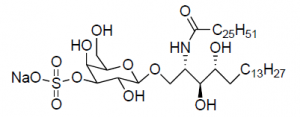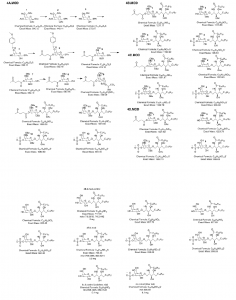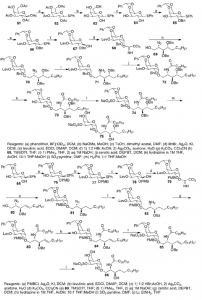Dylan Pratt, Brian Anderson, and Dr. Paul B. Savage
Abstract
The body’s innate immune system is continuously checking our body for molecular structures of antigens on potential pathogens. The CD1d antigen-presenting cell presents glycolipid antigens to Natural Killer T (NKT) cells. NKT cells start a signaling pathway that produces an inflammatory response. 3’’-O-sulfo-Beta-galactosylceramide has been shown to produce a stimulatory response with NKT cells [1]. This project involves the organic synthesis of structural variations of 3’’-O-sulfo-Beta-galactosylceramide. All of these molecules will be tested on their ability to stimulate NKT cells.
Introduction
The immune system is the body’s natural protection against pathogenic organisms such as bacteria and viruses. The immune system recognizes these pathogenic organisms as invaders by the presence of antigens that are on the pathogens. Antigens of pathogenic organisms are presented to two major classes of cells in the immune system: B-lymphocytes and T-lymphocytes. Upon stimulation by antigens, B and T lymphocytes are activated to fight against pathogenic organisms and keep our bodies healthy.
Sulfatides are a class of compounds that are galactose glycolipids. One particular sulfatide, 3’’-O-sulfo-Beta-galactosylceramide, shown on the next page, is a foreign antigen that was found to stimulate natural killer T (NKT) cells of the immune system [1]. This sulfatide is presented to NKT cells by an antigen-presenting cell called CD1d. As shown below, this sulfatide has two long alkyl chains. These alkyl chains fit into two hydrophobic pockets of CD1d. CD1d binds the sulfatide and presents it to NKT cells, thus activating NKT cells and beginning the fight against pathogenic invaders [2].

This project involves the organic synthesis of sulfatide derivatives that have specific structural differences in their alkyl chains. By making specific changes to the alkyl chains in sulfatides, their alkyl chains may be better able to bind into the two pockets of CD1d. If CD1d can more strongly bind to a sulfatide, it will be more effective at presenting that sulfatide to NKT cells. This would lead to increased activation of NKT cells and a stronger immune system response to pathogens. Much research has already been carried out by numerous groups to find the natural sulfatide that binds to CD1d [3, 4]. The synthesis of sulfatides has also been reported by several groups [5].
Methods
All of the work that I have done for this project has been in the lab of Dr. Paul B. Savage. I have been working under the direction of Brian Anderson, a PhD student in Dr. Savage’s research group. The work that I have done on this project consists mainly of the steps from the first starting material until the reaction where the sugar is coupled to the two lipid chains. I have done all of these steps for project 4 and many of these steps for project 5. Page 5 contains an overview of project 4 showing the basic steps of the starting materials and detailed structures of the final products that we are aiming for with this project. The bottom of page 5 also contains the amounts in milligrams (under the structure, formula, and mass) that we obtained of several of the final products that we have already finished in this project. Page 6 contains detailed reaction steps with reagents for project 5. The majority of the work that I have done with Brian in Dr. Savage’s lab has been on these two projects. The following schematics are from Brian Anderson.
Overview of Project 4
Reactions and Reagents of Project 5
Results
During the time that I have worked with Brian we have finished several final products. Those final products are listed at the bottom of page 5 with an amount in milligrams that we obtained. This project, and some others that I have also worked on, are still being worked on. I have included reactions and schematics for projects 4 and 5 because those are the projects that I have worked on the most. I have done a small amount of work in other areas of Dr. Savage’s lab and other projects of Brian’s. However, it would be very difficult for me to assess all of the work that I have done on every project that I have worked on in the lab. Almost all of the work I have done in the lab has been tasks that were assigned to me by Brian so that I could be of help to him in his graduate work.
Discussion
The sulfatides that we are making will be sent to our collaborators to be tested on their ability to stimulate a specific subset of T-cells that have not yet been tested with sulfatides. Our goal is to find a sulfatide that most effectively stimulates T-cells in a way that could be used for advancements in medicine.
Results
- Schmidt, R. R.; Kinzy, W. Advances Carbohydr. Chem. Biochem 1994, 50, 21.
- Stanic, A. K.; De Silva, A. D.; Park, J.; Sriram V.; Ichikawa, S.; Hirabyashi, Y.; Hayakawa, K.; Kaer, L. V.; Brutkiewicz, R. R.; Joyce. S. Proc. Natl. Acad. Sci. U.S.A. 2003, 100, 1849-1854.
- Brutkiewicz, R. R.; Lin, Y.; Cho, S.; Hwang, Y. K.; Sriram, V.; Roberts, T. Critic. Rev. Immunol. 2003, 23, 403-419.
- Zhou, D.; Cantu, C. III; Sagiv, Y.; Schrantz, N.; Kulkarni, A. B.; Qi, X.; Mahuran, D. J.; Morales, C.R.; Grabowski, G.A.; Benlagha, K.; Savage, P.; Bendelac, A.; Teyton, L. Science 2004, 303, 523-527.
- Slaghek, T. M.; Bliet, M.J.; Maas, A. A. M.; Kamerling, J. P.; Vliegenthart, J. F. G. Carbohydr. Res. 1989, 195, 75-86.


